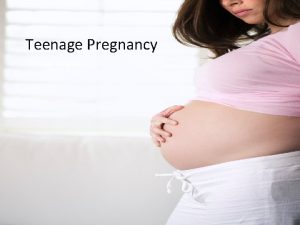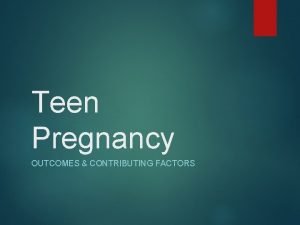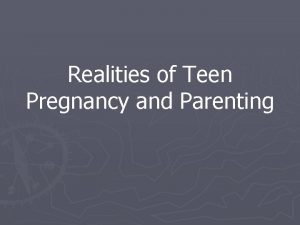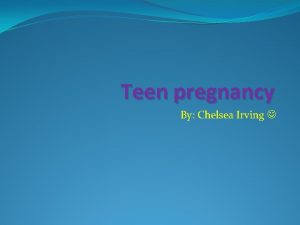Teen Pregnancy Teen Pregnancy Pretest True or False


















- Slides: 18

Teen Pregnancy…

Teen Pregnancy Pre-test (True or False) 1. 2. 3. 4. 5. 6. Teen mothers are twice as likely to die in childbirth. A child born to a teen mother is twice as likely to die before the age of one. Teen mothers are twice as likely not to finish high school. One-half of all welfare payments go to families with teen mothers. 20% of teen mothers are pregnant again before two years. 82% of girls who gave birth at age 15 or younger were born to teen parents.

Teen Pregnancy Pre-test (True or False) 7. 8. 9. 10. Most teen pregnancies happen by mistake – they were not planned. If a boy has already made plans for further education after high school, he should not have to worry about marrying a girl, even if she is pregnant. If a girl is pregnant, but the boy doesn’t want her to have the baby, he is not responsible for supporting the child financially. If the father wants custody and the mother doesn't, the father gets custody, because it's his baby.

Teen Pregnancy Pre-test (True or False) 11. 12. 13. 14. 15. If a girl gets pregnant a guy does not need to worry about it if he does not like the girl. If a guy does not have a regular job, he will not be responsible for child support. If a couple breaks up after the girl is pregnant, the guy has no responsibility for the child. It's a girl's fault if she gets pregnant. It's not the guy's problem. The divorce rate is greater for couples with a premarital pregnancy than for those who conceive after marriage.

Four in ten girls get pregnant at least once before age 20. Source: National Campaign to Prevent Teen Pregnancy analysis of Henshaw, S. K. , U. S. . Teenage Pregnancy Statistics, New York: Alan Guttmacher Institute, May, 1996; and Forrest, J. D. , Proportion of U. S. Women Ever Pregnant Before Age 20, New York: Alan Guttmacher Institute, 1986, unpublished.

We’re number one…unfortunately The United States has much higher pregnancy and birth rates than other fully industrialized countries. US pregnancy rates are nearly twice as high as rates in Canada and England seven to eight times as high as rates in Japan and the Netherlands. Singh, S. , & Darroch, J. E. (2000). Adolescent pregnancy and childbearing: Levels and trends in developed countries. Family Planning Perspectives 32(1), 14 -23. Pregnancy rates calculated as the sum of births, abortions, and estimated miscarriages (20 percent of births plus 10 percent of miscarriages).

The consequences of teen motherhood are many: Less likely to complete high school n Dependence on welfare n Single parenthood n More likely to have more children sooner on a limited income n More likely to abuse or neglect the child n National Campaign to Prevent Teen Pregnancy. (1997). Whatever Happened to Childhood? The Problem of Teen Pregnancy in the United States. Washington, DC: Author.

Risks to children of teen mothers growing up without a father n low birth weight and premature n school failure n mental retardation n insufficient health care n abuse and neglect n poverty and welfare dependence n Source: Maynard, R. A. , (ed. ), Kids Having Kids: A Robin Hood Foundation Special Report on the Costs of Adolescent Childbearing, New York: Robin Hood Foundation, 1996.

Only 32 percent of teen mothers get their high school diplomas 68% 32% National Campaign to Prevent Teen Pregnancy. (1997). Whatever Happened to Childhood? The Problem of Teen Pregnancy in the United States. Washington, DC: Author.

The children of teen mothers are at greater risk of abuse and neglect. 110 51 29 18 National Campaign to Prevent Teen Pregnancy. (1997). Whatever Happened to Childhood? The Problem of Teen Pregnancy in the United States. Washington, DC: Author.

55 teen girls give birth each hour. Nearly one-half million teen births occurred. To put it another way, more than 55 U. S. teens give birth each hour. Thirty-six percent of these births were to girls under the age of 18, and 64 percent were to girls aged 18 -19. Total: 484, 794 312, 186 163, 559 * 9, 049

State teen pregnancy rates (pregnancies per 1, 000 girls aged 15 -19) Teen pregnancy rates vary widely by state, ranging from 50 per 1, 000 in North Dakota to 140 per 1, 000 in Nevada. 50 -62 per 1, 000 65 -85 per 1, 000 86 -90 per 1, 000 95 -106 per 1, 000 108 -140 per 1, 000 The Alan Guttmacher Institute. (1999). Teenage pregnancy: Overall trends and state-by-state information. New York: Author.

Health Risks - Presents special health risks for both the teen and her baby. - Her body may not be ready for the demands pregnancy places on it. - More likely to suffer from iron deficiency and very high blood pressure. - Also more likely to develop urinary tract infections.

- Nutritional needs are high because her body requires all the nutrients for her own body, which doesn’t leave much for the growing baby. - These babies are more likely to be premature and have low birth weight. - These conditions are also linked to other problems from blindness to learning deficiencies.

Education - Higher drop out rate. Nearly half never complete their education. - Makes it harder to support themselves and the baby without a diploma.

-Good medical care is needed. . -Provide clothing , shelter, food and healthcare for the child.

- Teen parents may miss out on everyday activities because of caring for the child.

When Pregnancy Occurs n Single Parenthood t n Marriage t n Face special challenges because they take on the responsibility all alone. Socially isolated Adoption Closed- birth parents don’t know the names of the adoptive parents. t Open- birth parents are told about the adopting parents and may even meet them. t
 Amer rasheed
Amer rasheed Teen challenge nottingham
Teen challenge nottingham Menstruation during pregnancy symptoms
Menstruation during pregnancy symptoms Slidetodoc.com
Slidetodoc.com True or false calculator
True or false calculator Sentences with decide
Sentences with decide With the block format, all new paragraphs are indented.
With the block format, all new paragraphs are indented. True-false physical activity clues answers
True-false physical activity clues answers Phylum name
Phylum name Theocracy can coexist with monarchy true or false
Theocracy can coexist with monarchy true or false True or false
True or false Tempo
Tempo To whom much is given much is expected meaning
To whom much is given much is expected meaning Mla works cited indentation
Mla works cited indentation Folk dance is always done by music.
Folk dance is always done by music. Bird true or false questions
Bird true or false questions True false
True false Are these statement true or false
Are these statement true or false If acid is splashed on your skin, wash at once with *
If acid is splashed on your skin, wash at once with *


































